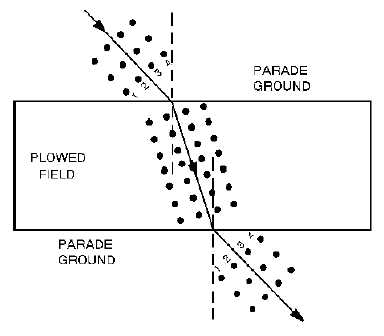1-16
Figure 1-11.—Analogy of refraction.
Q14. A refracted wave occurs when a wave passes from one medium into another medium. What
determines the angle of refraction?
Diffraction
DIFFRACTION is the bending of the wave path when the waves meet an obstruction. The amount of
diffraction depends on the wavelength of the wave. Higher frequency waves are rarely diffracted in the
normal world that surrounds us. Since light waves are high frequency waves, you will rarely see light
diffracted. You can, however, observe diffraction in sound waves by listening to music. Suppose you are
outdoors listening to a band. If you step behind a solid obstruction, such as a brick wall, you will hear
mostly low notes. This is because the higher notes, having short wave lengths, undergo little or no
diffraction and pass by or over the wall without wrapping around the wall and reaching your ears. The
low notes, having longer wavelengths, wrap around the wall and reach your ears. This leads to the general
statement that lower frequency waves tend to diffract more than higher frequency waves. Broadcast band
(AM band) radio waves (lower frequency waves) often travel over a mountain to the opposite side from
their source because of diffraction, while higher frequency TV and FM signals from the same source tend
to be stopped by the mountain.
Doppler Effect
The last, but equally important, characteristic of a wave that we will discuss is the Doppler effect.
The DOPPLER EFFECT is the apparent change in frequency or pitch when a sound source moves either
toward or away from the listener, or when the listener moves either toward or away from the sound
source. This principle, discovered by the Austrian physicist Christian Doppler, applies to all wave motion.
The apparent change in frequency between the source of a wave and the receiver of the wave is
because of relative motion between the source and the receiver. To understand the Doppler effect, first
assume that the frequency of a sound from a source is held constant. The wavelength of the sound will
also remain constant. If both the source and the receiver of the sound remain stationary, the receiver will



